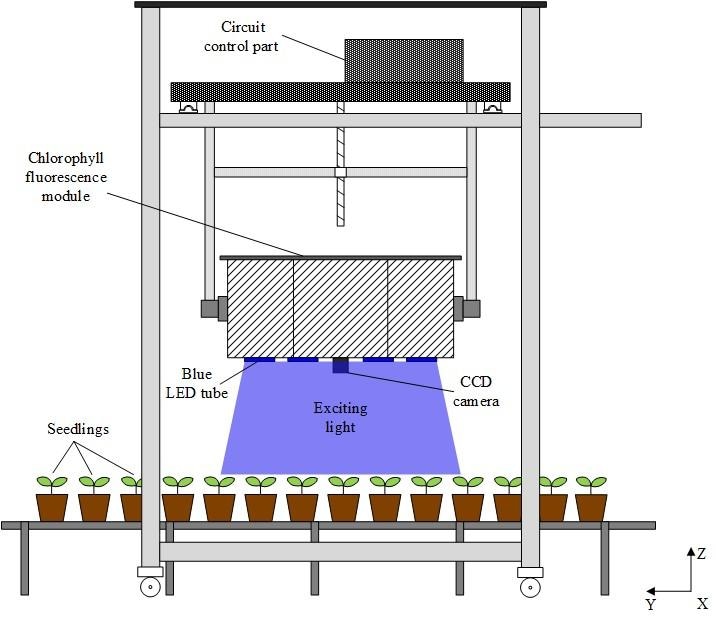Dec 8 2017
A new imaging system that monitors the health of crops in the greenhouse or field has been developed by researchers, headed by Xu Liu from Zhejiang University in China.
 A new fluorescence imaging system uses a large imaging area to provide information about plant health. It is designed for use in greenhouses or in the field and could one day enable farm machinery that automatically responds to plants showing stress. Image Credit: Haifeng Li, Zhejiang University.
A new fluorescence imaging system uses a large imaging area to provide information about plant health. It is designed for use in greenhouses or in the field and could one day enable farm machinery that automatically responds to plants showing stress. Image Credit: Haifeng Li, Zhejiang University.
The novel technology could potentially save farmers considerable amounts of time and money by allowing intelligent agricultural equipment that automatically provides nutrients or water to the plants at the first signs of distress. With further improvement, the new system could possibly be used aboard unmanned aerial vehicles to remotely observe crops.
Fluorescence is emitted from chlorophyll– a pigment that gives plants their green color and is important for absorbing the sunlight, which plants use to produce energy via photosynthesis. The innovative imaging system detects this emitted fluorescence. Tracking chlorophyll and how photosynthesis is carried out in a plant offers a better understanding about the growth and health of the plants.
Researchers have described their new crop imaging system in The Optical Society journal, Applied Optics. The system can image an area measuring 45 by 34 centimeters, approximately four times larger than chlorophyll imagers that are commercially available in the market.
“Most instruments used for chlorophyll fluorescence imaging are only suitable for laboratory use, but we want to develop a system that can monitor crop health in a field or greenhouse,” said Haifeng Li, a member of the research group. “The large detection area of our crop imager brings us closer to that goal.”
The new system will not only help farmers check crop health, but would also help study the way plants respond to changes in growing conditions as well as for high-throughput phenotyping. Phenotyping is an automated technique which is used in research and development of crops to examine how genetic modifications impact plant characteristics such as drought resistance or leaf size in many numbers of plants. The method could also be adjusted for microscopy, making it possible to image the process of photosynthesis within the plant cells.
“Chlorophyll fluorescence imaging has been widely used in academic research,” said Li. “Our system will allow this technique to move beyond the lab, where it can be used to develop and study crops with higher yield, for example.”
More data provides a better picture
Commercially available chlorophyll fluorescence imagers have limited imaging area that restricts these instruments to imaging just one or two seedlings at a time. In effect, some imagers are only capable of capturing fluorescence from just several leaves at a time. Since the process of photosynthesis can differ from one plant to another and even from one leaf to another, there is a need to acquire multiple images to get a picture of the overall crop growth.
In a single picture, the novel crop imager can capture fluorescence from seven or eight seedlings, based on their size. The data provided by these additional plants is enough to obtain a clear picture of crop health from just a single image. A scanning mechanism that increases the imaging area to 2 meters wide was also incorporated by the team.
“By acquiring a large amount of data, our system can significantly reduce the error involved in analyzing the physiological status of a crop and the monitoring efficiency of crop growing conditions, without requiring repeated sampling,” said Li.
Large-area illumination
In order to detect fluorescence from chlorophyll, the pigment has to be irradiated with light that activates molecules in the chlorophyll, causing them to produce light. Sixteen lighting module, each with a high-power LED, were used by the researchers to create this excitation light.
For each lighting module, a series of lenses and optical components were designed by the researchers. These lenses and components produced a rectangular illumination area through a process known as spot reshaping. Light from each lighting module was concentrated onto the middle of the imaging area and then superimposed to produce strong and uniform lighting.
“The 45- by 34-centimeter imaging area is the largest available for this type of imaging system,” said Li. “Our instrument uniquely uses LED lighting spot reshaping to accomplish even illumination across the entire imaging area and to ensure that most of the light energy is used for illumination and not wasted."
To test the new deice, the team imaged cucumber seedlings that are grown under stressful conditions, which involved either nitrogen or water deficiency. In both cases, the instrument exhibited changes in chlorophyll fluorescence that matched with the declining plant health over time.
The team is now working to boost the light energy utilization of the system by improving the manufacturing methods, such as integrating lens coatings that are used to make the optical components. The researchers also intend to reduce the volume and weight of the imager and make it more practical and more mobile for use in greenhouses and in the field.